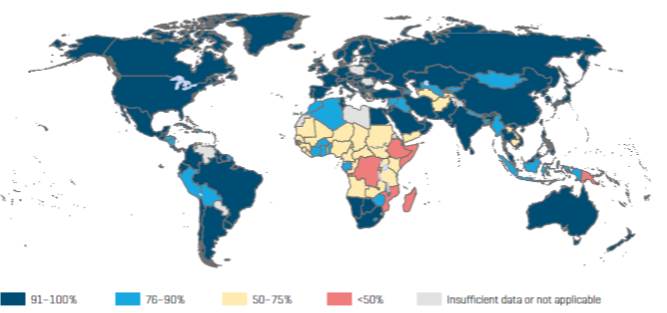|
Ensuring Safe Water and
Sanitation T he Millennium Development Goals were adopted in 2000, as a vision for development to eradicate poverty by 2015. Under the goal of Ensuring Environmental Sustainability, a target for safe drinking water was set. However, the inter-connectedness of water with other goals and basic sanitation was only added in the year 20021. It was established that 75% of the world must have access to a sanitation facility.Between 1990 and 2010, nearly two billion people gained access to improved drinking water sources. This entailed an increase from 76% in 1990 to 89% in 2010. While the target for water was achieved in 2010, the current trends in the sanitation target paint a dismal picture. Since 1990, nearly 2 billion people have gained access to an improved sanitation facility; but 2.5 billion people are still left behind 2, of which 1 billion (15% of world population) practice open defecation, with 60% residing in India3.The MDGs were set with no reference to the initial conditions prevailing in various countries. This makes measuring achievement problematic. It is difficult to differentiate areas with substantial progress from those with little progress 4. For example, the diagram shows several regions with poor performance on the water front even though the target was met officially5:Furthermore, globally the MDG on water and sanitation has narrowly focused on the number of people who have gained access. Currently, the indicator for achievement on the water front is: provision of infrastructural facilities. The quality of water supplied together with collection time and the outcomes are completely ignored 6.
There are large disparities in distribution of water and sanitation services. As per the 2011 Census of India, in urban areas 62% of the households have tap water from treated sources, whereas for rural areas itís 17.9%. Similarly for sanitation, more than 81% of the population has improved facilities in urban areas; the same for rural areas stands at 30.7% 7.
Proportion of Population Using Improved Sources of Drinking Water, 2011 Besides a rural-urban disparity, there exists a gender disparity. Women and girls are more likely to bear the burden of water collection and suffer the indignity of open defecation, making them vulnerable to rape and assault. Hence, we need to broaden the scope of access and incorporate quality, sustainability and equity dimensions. The formulation of Sustainable Development Goals (SDGs) provides us with this opportunity. SDGs should focus on providing universal access to safe drinking water and sanitation. Within the access component, we need to move beyond home and ensure access to schools and health centres. The outcomes of such provision are: increased attendance, enhanced performance of students and promotion of gender equality. Reducing inequity is essential8. SDG framework must incorporate the needs of people with disabilities, women and other marginalised groups. For instance, decreased water collection time and improved health (through cleaner water and proper sanitation and hygiene) result in more time for women for education and productive work, positively affecting their income. Furthermore, a benchmark for the quality of water along with a mechanism for its tracking must be established. The SDGs must focus on sustainability of water and sanitation source, concurrently ensuring systems for its governance, service, delivery and costing/pricing are formed. q Kavneet Kaur 1 IRC, 2004, Monitoring Millennium Development Goals 2 http://www.un.org/millenniumgoals/environ.shtml 3 Joint Monitoring Programme Report, 2012, Progress on Drinking Water and Sanitation 4 Nayyar,2012, The MDGs after 2015: Some Reflections On The Possibilities 5 Joint Monitoring Programme Report, 2013, Progress on Sanitation and Drinking Water 6 Joint Monitoring Programme Report, 2012, Progress on Drinking Water and Sanitation 7 Government of India, 2013, Towards Achieving Millennium Development Goals India 8 Joint Monitoring Programme Report, 2013, Progress on Sanitation and Drinking Water |